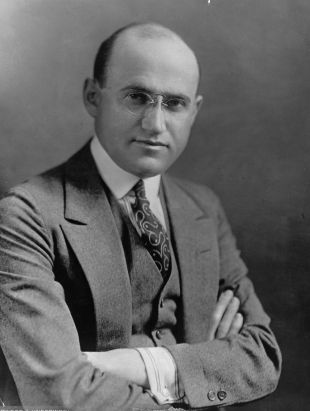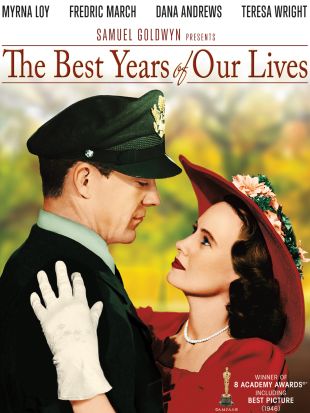One of the most distinguished of the old Hollywood movie moguls, Samuel Goldwyn probably rose the farthest of them all from the humblest of beginnings. Born Schmuel Gelbfisz in Warsaw, Poland, in 1879, he grew up in a life of dire poverty. At age 16, he headed west on foot, adopted the name Samuel Goldfish, worked, begged, and perhaps also stole to survive, and then got passage on a ship to Nova Scotia. After arriving in New York without a penny to his name, he began working his way up the corporate ladder at a glove company. In the process of living a middle-class American life, he developed one special cultural love and fixation -- the movies, which were just becoming a vehicle for serious entertainment. In 1913, Goldfish and his brother-in-law, the vaudeville producer Jesse L. Lasky, went into business together, forming the Jesse Lasky Feature Photoplay Company; their debut release, The Squaw Man (1914), directed by Cecil B. DeMille, was an enormous hit. Their company had a good three years before it merged with Adolph Zukor's Famous Players studio, thus forming the nucleus of what became Paramount Pictures. Soon after, Goldfish went into partnership with Edgar Selwyn in a company called the Goldwyn Pictures Corp., which took its name from the first syllable of Goldfish's name and the last one of Selwyn's -- Samuel Goldfish himself soon adopted Goldwyn as his own legal name.
The original Goldwyn company merged with Metro Studios and Louis B. Mayer's production company in the early '20s to form Metro Goldwyn Mayer, but Samuel Goldwyn wasn't long in that partnership. He exited in 1923, leaving the Goldwyn corporate name as part of MGM -- a fact that would cause him some mild distress in later years, owing to the public's confusion -- and formed Samuel Goldwyn Productions, the company that he was to run for the next four decades. Goldwyn 's philosophy, in contrast to that of the other major studios, was to make one picture at a time, but make it very well, sparing no expense in bringing the best actors, directors, designers, composers, and writers together to create only the finest in feature films -- Goldwyn never made B-pictures, and every Samuel Goldwyn production was an important film, getting the full devotion of its producer's resources and attention. In its heyday, at any given moment the company had one film at the pre-production stage, one movie in the process of being completed, and one film in release.
The company came into its own with the arrival of sound. Bulldog Drummond, Street Scene, and Arrowsmith, were all huge successes, and Goldwyn also exerted a profound influence on the development of movie music during the sound era through his hiring of Alfred Newman, a young New York-based conductor and arranger, to work as music director on the 1930 Eddie Cantor musical Whoopee! -- Newman proved to be an inspired choice for that film and went on (beginning with Goldwyn's Street Scene) to become one of the most influential composers of movie music over the next 35 years. Goldwyn's one-film-at-a-time approach proved completely competitive with the more factory-like methods of production utilized by his ex-partners at MGM and Paramount, and he became one of Hollywood's great success stories -- indeed, to this day, more than a quarter century after his death and four decades since his last new film went into release, Samuel Goldwyn is the most successful independent producer in the history of Hollywood. Included in the Goldwyn company's illustrious talent pool at various times were Ronald Colman, Gary Cooper, Laurence Olivier, Merle Oberon, Eddie Cantor, Danny Kaye, David Niven, Will Rogers, Walter Huston, Susan Hayward, and Joel McCrea; director William Wyler; the composers Alfred Newman and George and Ira Gershwin; choreographer Busby Berkeley; and the authors Lillian Hellman, Sinclair Lewis, and Robert Sherwood. Goldwyn 's films, whether serious dramas like These Three (1936) (a partly censored version of Hellman's play The Children's Hour), Dodsworth (1936), Wuthering Heights (1939), and The Little Foxes (1941), or comedies like Ball of Fire (1941), were all quality entertainment -- indeed, his family films such as Hans Christian Andersen (1952) rivaled the best live-action movies that Disney created, while his musicals, from the early Eddie Cantor vehicles (Whoopee! [1930], Palmy Days [1931], and Roman Scandals [1933]) up through Guys and Dolls (1955), starring Frank Sinatra and Marlon Brando, were more than a match for any contemporary releases by Warner Bros. or MGM.
Goldwyn 's focus on quality allowed him to transcend his own limitations. The perfect example is The Pride of the Yankees (1942), which is generally regarded as the best movie biography of a sports figure of all time. During WWII, his film output was weighted decidedly toward comedy and he delighted audiences by the millions with films like Up in Arms, Wonder Man, andThe Princess and the Pirate. Goldwyn reached his peak as a producer, however, with his best and most serious film -- The Best Years of Our Lives, a 181-minute drama about returning servicemen and their families that not only won eight Academy Awards (including Best Picture and Best Director for William Wyler), but has endured as perhaps the best and most watchable of all of Hollywood's old-style dramatic epics.
Like many of the other moguls, Goldwyn's judgment and business fortunes faltered in the years after WWII, and he saw disappointing returns for endeavors like The Bishop's Wife, Enchantment, Ball of Fire, A Song Is Born, My Foolish Heart, and The Elusive Pimpernel. He did find some success with Hans Christian Andersen (1952) and Guys and Dolls (1955), however, his adaptation of the musical Porgy and Bess was so ill received that the estate of the play's original composer, George Gershwin, withdrew it from circulation as soon as the term of Goldwyn's license on the material expired.
Goldwyn ceased production in 1959 following the release of Porgy and Bess, the first time since 1913 that he had been out of the movie business. Because his company owned virtually every picture it ever produced, however, Goldwyn 's films continued to enjoy prestige presentations on television and in theatrical presentation well past his retirement, and Samuel Goldwyn was still a well-known, beloved name in moviemaking when he died 15 years after retiring. His movies have continued to be shown only in the best broadcast and cable venues, and to receive the most respectful home video treatment in the decades since. Indeed, the Samuel Goldwyn Company, run by Samuel Goldwyn Jr., experienced a major expansion of its own in the 1980s when it bought the American distribution rights to the library of Alexander Korda's London Film Productions, and also financed a reissue of Tony Richardson's 1963 hit Tom Jones. The combined Goldwyn and Korda libraries reached a new high point of presentation when they were licensed by HBO Home Video in the early '90s, which invested money heavily in the remastering and upgrading of their film materials and shot excellent supplementary wrap-around and commentaries for the laser disc releases of movies such as The Best Years of Our Lives (which was available for a time at the end of the 1990s on DVD from HBO with those extra materials). Additionally, Samuel Goldwyn's knack for finding or approving properties with enduring appeal to the public was borne out in 1996, 22 years after his death, when The Bishop's Wife was remade successfully by Penny Marshall as The Preacher's Wife.


_Poster.jpg)
